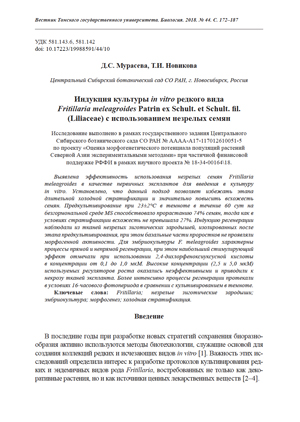NEWS 2018
In vitro culture initiation using immature seeds of a rare species Fritillaria meleagroides Patrin ex Schult. et Schult. fil. (Liliaceae)
Dinara S MURASEVA, Tatyana I NOVIKOVA
Vestnik Tomskogo gosudarstvennogo, Universiteta Biologiya, Tomsk State University Journal of Biology 44:172-187(2018)
https://doi.org/10.17223/19988591/44/10
Central Siberian Botanical Garden, Siberian Branch RAS, 630090 Novosibirsk, Russia
Abstract
Fritillaria meleagroides Patrin ex Schult. et Schult. fil. is a perennial herbaceous ephemeral bulbous plant. The importance of the natural flora biodiversity conservation has determined the interest in development of culture protocols of this rare species. The aims of the present study were to identify optimal conditions for immature seeds cultivation as primary explants and to induce the morphogenesis from immature zygotic embryo tissue and seedlings of F. meleagroides.
We collected immature fruits from plants of the natural population located in Novosibirsk Oblast, Toguchin Region, the Izyli River floodplain (55°10'21.8''N, 84°34'54.8''E). The fruits were sterilized by immersion into 15% aqueous solution of “Domestos” for 20 min. The scheme of the experiment is shown in Figure 1. We precultivated immature seeds for 40 or 60 days under continuous darkness on 0.6% water agar or hormone-free MS medium. Two temperature regimes - 4 °С and 23±2 °С were tested. Morphogenesis from immature zygotic embryo tissue and the basal part of seedlings was induced under a 16-h photoperiod or continuous darkness at 23±2 °С on MS medium supplemented with thidiazuron (TDZ) or 2.4-dichlorophenoxy acetic acid (2.4-D) at a concentration of 0.1-5.0 μM. Hormone-free MS medium was applied as a control. The passage at this stage lasted for 60-75 days. We evaluated the frequency of callusogenesis (%), regeneration rate (%) and the number of protuberances or shoots per explant at the end of the passage at the morphogenesis induction stage.
We observed seed germination with a rate of 21% after 40 days of precultivation at cold stratification, whereas at 23±2 °С germination was not recorded (See Table 1). After 60 days of precultivation, the germination rate at cold stratification achieved 27%, at the same time 74% of seeds were germinated on hormone-free MS medium at 23±2 °С (See Fig. 2). We found that using the basal parts of seedlings was not effective at the induction stage. Two types of callus formed from zygotic embryo tissue under a photoperiod: dense nonmorphogenic and friable granular morphogenic (See Fig. 3 and 4). The maximum number of globular protuberances developed on callus was obtained on the control medium; the minimum was on MS supplemented with TDZ 0.1 μM (See Table 2). We also observed direct shoot regeneration in immature zygotic embryo culture. The largest rate (40%) of adventitious shoot formation was achieved on MS medium with 2.4-D 1.0 μM, but the regeneration rate decreased significantly at higher concentrations (See Table 3). Cultivation on the media supplemented with TDZ resulted in the absence of direct gemmogenesis without necrosis processes. Under continuous darkness, the callus formed more actively, but morphogenic callus and the number of globular protuberances did not change significantly (See Table 2). Low concentrations of 2.4-D were more efficient for induction of the direct regeneration: the maximum of shoot regeneration rate (38%) with 4.0 of adventitious shoot on the average per explant was obtained at 0.1 μM. Thus, we established the effectiveness of using immature zygotic embryo isolated from seeds after precultivation to induce direct and indirect shoot regeneration. The need for a long cold stratification of seeds was eliminated.




